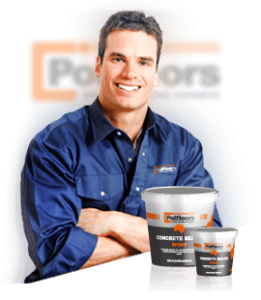Mixing the epoxy coating
A DIY guide on How to apply an epoxy garage flooring
This post is a part of A DIY guide on How to apply an epoxy garage flooring
The following instructions apply to every coat that you will apply to your garage floor. Always read the manufacturer’s instructions first
Before starting, lay the tarp down on your driveway in front of the garage to determine your work area. Tape down the edge of the tarp to the edge of the garage floor to ensure that nothing spills on your driveway. Ensure that all the tools and materials that you require are available and laid out. After that, put on the spiked shoes and the gloves.
Tip: Be careful as spiked shoes may be slippery on the coating. Make conscious and careful steps.
Before mixing, make sure that no settling has occurred in the containers from sitting. If that happens, separately mix the Part A resin and part B hardener in their specified containers so that the contents are equally distributed.
It is easier to mix part A and part B containers by hand with separate stir sticks unless you are dealing with 20l units. Be careful not to mix residue part A into B or vice versa, otherwise a chemical reaction will start. For 20l units, a paddle mixer should be used, use separate paddles or clean the mixer well before each mixing.
If your floor requires more than one container of Part A and Part B per coating, it is advised to batch mix. This is done by pouring all Part A and all Part B containers into individual buckets to mix separately. This will ensure you get color and product uniformity. Mix the color packets for pigment in to Part A resin for color uniformity.
Start pouring the Part B hardener into a 20l mix bucket and then add the Part A resin. The Part A is stickier and the Part B hardener is lower in viscosity and weight. It will flow up and around the sides of the bucket when the Part A is poured in. If this is the last coat and you have decided to use an anti-slip additive, then you can add that now as well.
If you have decided to do your garage floor in small separate portions or you batch mixed the epoxy for each coat, do not mix the entire batch of Part A and Part B at once. First measure the required amounts of Part A and Part B in separate calibrated containers and then add these to your mixing bucket when you are ready.
Slowly mix the epoxy for at least 2 minutes using your mixing paddle and drill. Ensure that you mix around the sides and the bottom of the bucket to make sure that all the contents are well mixed. There should be no colored veins left. If the components are not properly mixed with the epoxy, this will lead to curing problems because the epoxy will not cross link. This will result in a substandard coating.
To avoid introduction of air into the epoxy, it is important not to drill too fast or pump the mixing paddle as this will cause air bubbles in the coat later on the surface. The epoxy should have an even consistency and no color streaks.
Tip: As soon as you begin mixing, the chemical reaction starts and that is the official start of your pot life. It is essential to start a clock when you begin to keep track of time (working time of the epoxy).
Always follow the manufacturer’s instructions when you mix the epoxy. Make sure that all the measurements are correct when you mix smaller quantities. Check the manufacturer’s instructions if you are using something other than 100% solids epoxy. It is important that the mix sits for a required amount of time before it is applied to the concrete. If this is not allowed, then the coating may not harden properly.
Note: When 100% solids epoxy is used, it should be poured on the floor as soon as it is mixed and it should not sit in the bucket for even a minute. This can shorten the pot life by half or more

